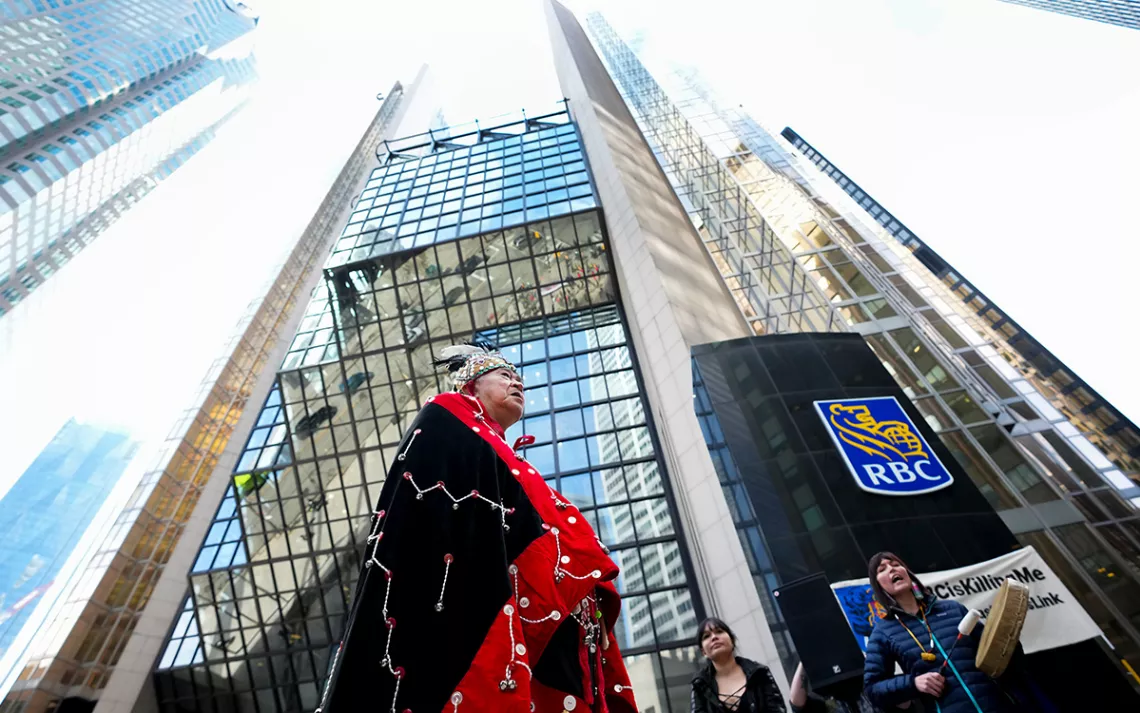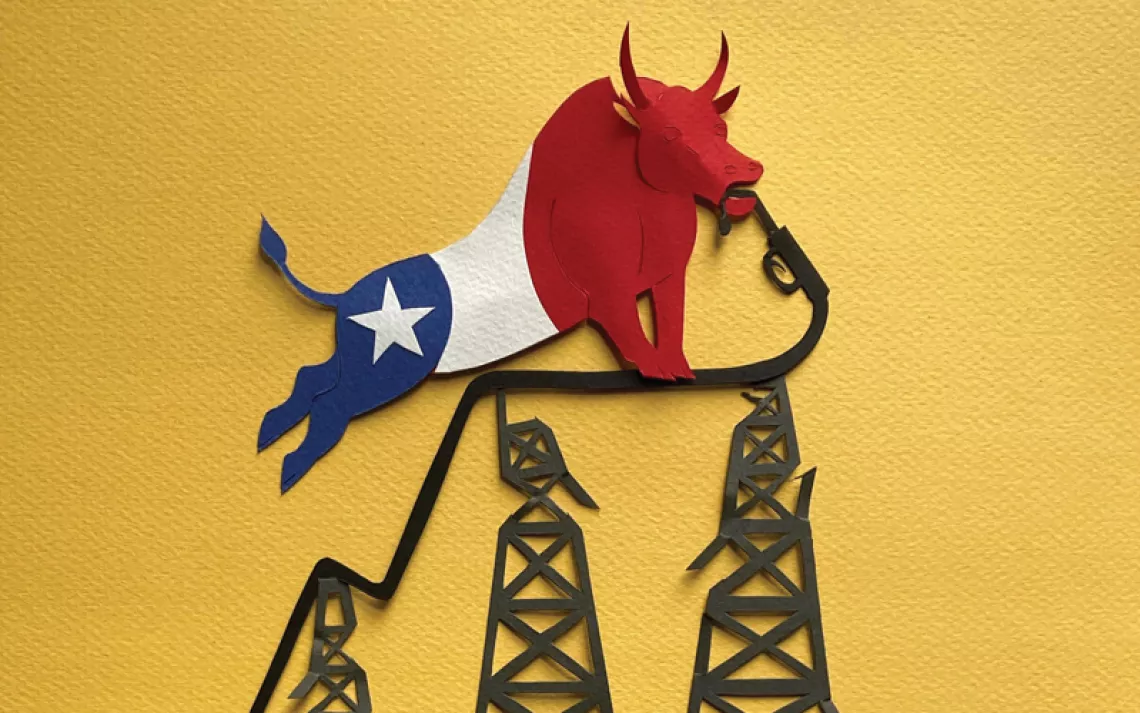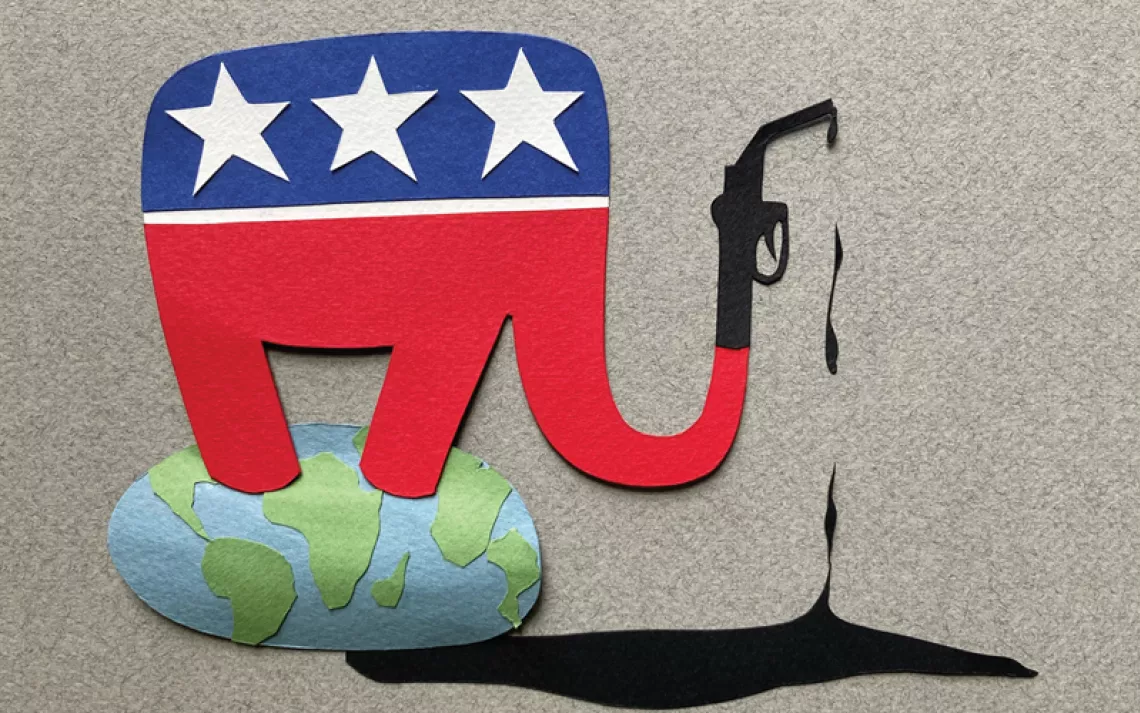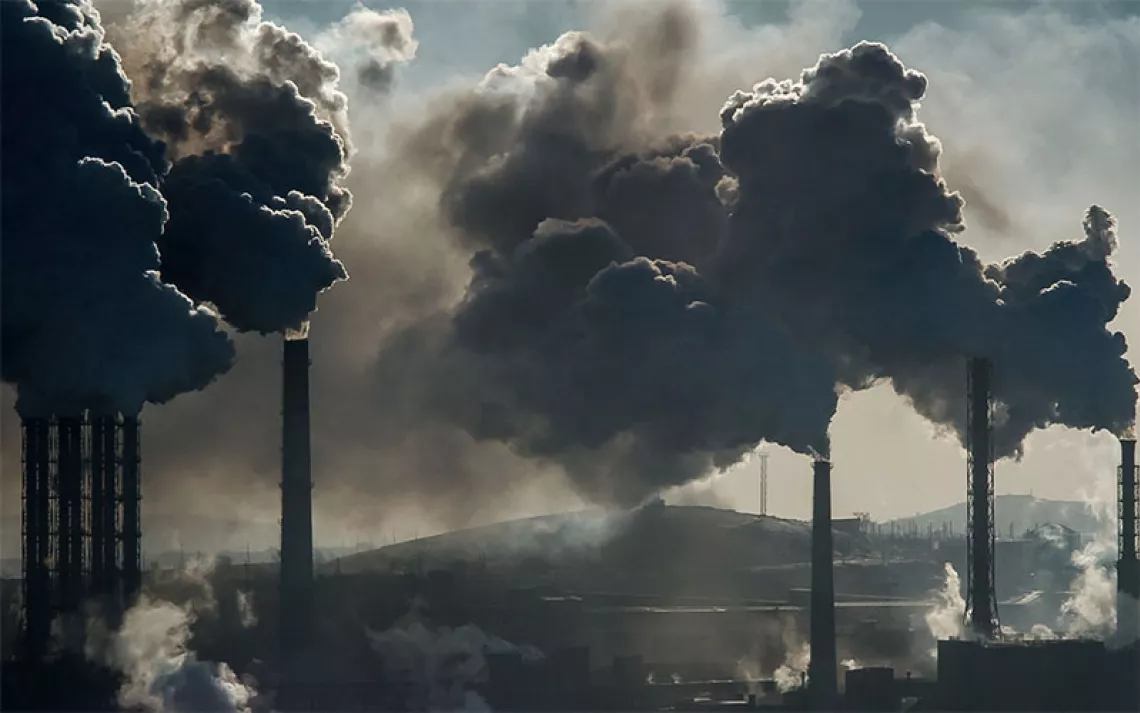Canada’s RBC Tops List of Banks Financing the Climate Crisis
Fossil fuel companies use loopholes to get billions in financing, according to “Banking on Climate Chaos”

In Toronto, Wet'suwet'en Chief Madeek (Jeff Brown) protests Royal Bank of Canada's funding of the Coastal GasLink Pipeline and other fossil fuel investments. | Photo by Nathan Denette/The Canadian Press via AP
Canada’s biggest lender, the Royal Bank of Canada (RBC), has a “Climate Commitments” splash page on its website that features pictures of children walking in nature and windmills spinning in the distance. The bank touts its commitment to net-zero emissions by 2050 and 70 percent reduction in GHG emissions by 2025, among other principles. “Climate change is one of the most pressing issues of our age,” the bank insists. “As Canada’s biggest bank, and one of the largest in the world based on market capitalization, we have an important role in supporting the most significant economic transition in centuries.”
According to the latest Banking on Climate Chaos report, RBC’s actual lending practices tell a much different story: The role RBC plays most often is the lender of last resort for the fossil fuel industry.
In 2022, Canada’s biggest bank shoveled $42.5 billion to fossil fuel projects, with $4.8 billion going to support tar sands operations and $7.4 billion for fracking. RBC funds the Coastal GasLink Pipeline—which the Wet'suwet'en Nation and other land defenders have been resisting for years and recently protested at the bank's annual general meeting and 40 branch locations—and the Enbridge Line 3 Pipeline, which threatens the Great Lakes. In spite of its stated support of the 2015 Paris Agreement, RBC has delivered a total of $253 billion to the companies whose operations are directly undermining that landmark climate treaty. The bank’s generous lending for projects known to release climate-destroying emissions such as methane and carbon dioxide make it the world’s worst funder for such projects in 2022—a first for the bank in the report’s 14-year history. Until now, JPMorgan Chase typically topped the list as the biggest funder of fossil fuels.
Altogether, the Banking on Climate Chaos report sketches a grim picture of the expansion of fossil fuel industries thanks to continued support from lenders. Financing for LNG (liquefied natural gas) projects increased by 50 percent in 2022, with RBC and JPMorgan Chase the two top financiers overall. A similar story can be found for coal. The burning of coal for energy contributes more than 40 percent of CO2 emissions worldwide, making the phase-out of all coal activities essential to any global climate action plan. The majority of financing for coal projects now comes from Chinese banks. The top 10 list of banks most responsible for financing coal mining companies is a Who’s Who of Chinese lenders, including Industrial Bank, Bank of China, China CITIC Bank, and China Everbright Bank. None of the 13 Chinese banks studied for the report have any policy limiting the financing of coal projects.
“There is room for financial actors at every location within the global financial system to shift their priorities in order to bring us rapidly to decarbonization and away from fossil fuels to keep the planet livable.”
“We need immediate efforts at decarbonization that are producing results. We are not going to achieve that without significantly moving away from fossil fuels. That is going to involve shifting finance, including finance from commercial banks, away from fossil fuels and toward a people-centered energy system,” April Merleaux, research manager for Rainforest Action Network, one of the authoring organizations of Banking on Climate Chaos, told Sierra.
“There is room for financial actors at every location within the global financial system to shift their priorities in order to bring us rapidly to decarbonization and away from fossil fuels to keep the planet livable.”
US-based banks still dominate most measures of fossil fuel financing. JPMorgan Chase—which is the worst funder of fossil fuels of all time, according to the analysis—and Citi, Wells Fargo, and Bank of America are among the top five worst lenders. French bank BNP Paribas—which recently spun off its US subsidiary Bank of the West to Canada’s Bank of Montreal—topped out the list of the worst financial institutions in Europe funding the climate crisis, with $20.8 billion in 2022. Bank of Montreal—which has now adopted Bank of the West’s “One percent for the planet” marketing campaigns—is among the top three worst funders of tar sands oil extraction. The Mitsubishi UFJ Financial Group was the worst among Asian banks, with $29.5 billion.
In total, according to the analysis, the world’s 60 largest banks are plowing forward with fossil fuel lending in spite of the Paris Agreement and the increasingly dire reports from the Intergovernmental Panel on Climate Change. Since the adoption of the Paris Agreement in 2015, those 60 banks combined made a whopping $5.5 trillion available to fossil fuel companies—the very industry most responsible for the crisis.
Not only are banks ramping up instead of ramping down their lending to fossil fuel companies, the report shows this trend continues even when those dirty energy companies aren’t asking for it. In 2022, oil corporations such as ExxonMobil, Suncor, and Shell were so flush with cash from windfall profits that they asked for no financing at all. Yet banks still showered them with $673 billion in lending that year.
Meanwhile, most major banks are spending more time greenwashing their climate image than engaging in actual pathways for addressing the climate crisis. While they publish colorful pages featuring windmills and forests, their lending practices directly contradict the policies needed to achieve that greener, more sustainable world. RBC, for example, is among the dozens of lenders that have some kind of net-zero decarbonization target. Yet many of the commitments those banks make are grounded in dubious hypotheticals from such unproven solutions as carbon offsets or carbon capture and storage. Canada's Competition Bureau opened an investigation into RBC in October for deceptive climate marketing practices.
The analysis also shows that membership in the United Nations Net-Zero Banking Alliance does nothing to slow down a bank’s lending to fossil fuel projects. Researchers examined 43 banks that are part of the alliance and found that in 2022 they had combined to make $111.6 billion in funding available to the top 100 companies responsible for fossil fuel expansion. “Without massive mobilization of capital away from the fossil fuel sector and into renewable energy and conservation, we won’t be on a sustainable path to 1.5°C,” said Adele Shraiman, a senior campaign representative for the Sierra Club's Fossil Free Finance. The Sierra Club is one of the authoring organizations of Banking on Climate Chaos. “We need banks to put their money where their mouth is.”
“We need banks to put their money where their mouth is.”
The report lays bare the loopholes in bank policies that lead to funding for fossil fuel projects. The Arctic is a prime example. Major US banks have adopted policies stipulating that they will restrict financing for oil-and-gas-specific projects in the Arctic. To get around their own prohibitions, banks often categorize loans to companies that are exploring Artic oil drilling as general corporate financing, not policy-specific financing.
This was the case with ConocoPhillips, which is moving ahead with its Willow project for drilling on Alaska’s North Slope. All the banks that lended to ConocoPhillips in 2022 have some kind of policy of excluding lending for projects in the polar region. But those exclusions only apply to project-specific proposals, not for general corporate purposes. For this reason, ConocoPhillips was able to receive lending in spite of its Willow project.
“If I went to a bank and asked for a loan but wouldn’t tell them what I was going to do with the money, they probably wouldn’t give me the money,” Merleaux said. “Banks need to ask for accountability from corporate clients around what they are doing with the finance they are getting. Banks should not be financing companies like ConocoPhillips, even if they are not asking for project-related finance.”
The project-finance loophole is one of the biggest reasons fossil fuel companies are able to skirt their climate pledges. According to Merleaux, the latest research shows that from 2016 to 2022, about 4 percent of all financing for fossil fuel companies was project specific. That means that most bank exclusion policies would not apply to 96 percent of the financing going to the fossil fuel industry.
Banking on Climate Chaos lays out a series of demands for systemic change in the financial sector should the world keep global warming to 2.7°F, or 1.5°C. Among the recommendations, the report asks that financial institutions commit to stop financing the expansion of the fossil fuel industry, including no financing for new infrastructure build-out and no development of reserves or exploration. The report asks banks to cut off financing to a fossil fuel company if it doesn’t live up to decarbonization targets and timelines and asks banks to commit to zeroing out funding for fossil fuels altogether. One example of a bank doing this is La Banque Postale, which announced in 2021 that it would end financing for fossil fuels. Analysts found that the bank had followed through on its pledge: In 2022, La Banque Postale had $0 on its balance sheet for such funding.
 The Magazine of The Sierra Club
The Magazine of The Sierra Club







